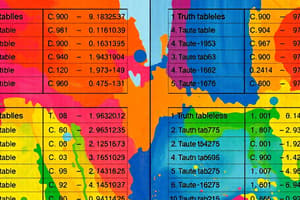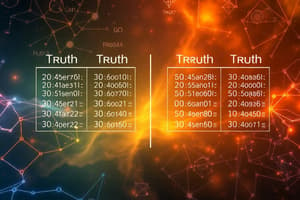Podcast
Questions and Answers
What is the result of ¬(p ∧ q) for the case when both p and q are true?
What is the result of ¬(p ∧ q) for the case when both p and q are true?
- False (correct)
- Undefined
- Neither true nor false
- True
Which of the following expressions is logically equivalent to ¬(p → q)?
Which of the following expressions is logically equivalent to ¬(p → q)?
- p ∧ ¬q (correct)
- ¬p ∨ q
- ¬p → q
- ¬p ∧ q
De Morgan's Laws state that ¬(p ∧ q) is equivalent to which expression?
De Morgan's Laws state that ¬(p ∧ q) is equivalent to which expression?
- p ∨ q
- ¬p ∨ q
- ¬p ∨ ¬q (correct)
- ¬p ∧ ¬q
If φ and ψ are two propositional logic statements that are logically equivalent, what can be inferred about their truth values?
If φ and ψ are two propositional logic statements that are logically equivalent, what can be inferred about their truth values?
Which statement is true regarding the logical connective '≡'?
Which statement is true regarding the logical connective '≡'?
What is a proposition?
What is a proposition?
Which logical connective represents 'and'?
Which logical connective represents 'and'?
What does the logical connective ¬p represent?
What does the logical connective ¬p represent?
How are propositional variables typically represented?
How are propositional variables typically represented?
Which of the following is an example of logical disjunction?
Which of the following is an example of logical disjunction?
What is propositional logic primarily used for?
What is propositional logic primarily used for?
Which statement is a proposition?
Which statement is a proposition?
Which of the following is NOT a characteristic of propositional logic?
Which of the following is NOT a characteristic of propositional logic?
What does the expression ¬(p ∧ q) represent?
What does the expression ¬(p ∧ q) represent?
Which of the following correctly translates 'I will be eaten by a velociraptor if there is one outside my apartment'?
Which of the following correctly translates 'I will be eaten by a velociraptor if there is one outside my apartment'?
In propositional logic, how is 'p, but q' represented?
In propositional logic, how is 'p, but q' represented?
Which logical connective has the highest precedence in propositional logic?
Which logical connective has the highest precedence in propositional logic?
How can we show that ¬(p ∧ q) and ¬p ∨ ¬q are equivalent?
How can we show that ¬(p ∧ q) and ¬p ∨ ¬q are equivalent?
What does the statement '¬a → ¬e' imply?
What does the statement '¬a → ¬e' imply?
What characterizes an operator as right-associative in propositional logic?
What characterizes an operator as right-associative in propositional logic?
Which statement reflects a common misconception about implication in propositional logic?
Which statement reflects a common misconception about implication in propositional logic?
What does the implication p → q signify?
What does the implication p → q signify?
When is the implication p → q considered false?
When is the implication p → q considered false?
What does the biconditional p ↔ q indicate?
What does the biconditional p ↔ q indicate?
Which symbol represents a value that is always true?
Which symbol represents a value that is always true?
What happens when p is false in the implication p → q?
What happens when p is false in the implication p → q?
What defines the truth table for p ↔ q?
What defines the truth table for p ↔ q?
What is not a function of the implication p → q?
What is not a function of the implication p → q?
Which connective connects zero propositions?
Which connective connects zero propositions?
Flashcards
Propositional Logic
Propositional Logic
A system for reasoning about statements that can be true or false.
Proposition
Proposition
A declarative statement that is either true or false.
Propositional Variable
Propositional Variable
A letter (e.g., p, q) representing a proposition that can be true or false.
Negation
Negation
Signup and view all the flashcards
Conjunction
Conjunction
Signup and view all the flashcards
Disjunction
Disjunction
Signup and view all the flashcards
Implication
Implication
Signup and view all the flashcards
Biconditional
Biconditional
Signup and view all the flashcards
Truth Table
Truth Table
Signup and view all the flashcards
Logical Equivalence
Logical Equivalence
Signup and view all the flashcards
De Morgan's Laws
De Morgan's Laws
Signup and view all the flashcards
Operator Precedence
Operator Precedence
Signup and view all the flashcards
English to Propositional Logic
English to Propositional Logic
Signup and view all the flashcards
Implication Causation
Implication Causation
Signup and view all the flashcards
Study Notes
Propositional Logic Overview
- Propositional logic is a system for reasoning about statements that can be true or false.
- A proposition is a declarative statement, such as "Puppies are cuter than kittens."
- Non-propositions include questions, commands, or ambiguous statements.
Key Components of Propositional Logic
- Propositional Variables: Represented by lower-case letters (p, q, r, etc.), each variable can either be true or false.
- Logical Connectives: Include operations to form complex propositions:
- Negation (¬): True if the proposition is false.
- Conjunction (∧): True only if both propositions are true.
- Disjunction (∨): True if at least one proposition is true.
- Implication (→): True except when the first proposition is true and the second is false.
- Biconditional (↔): True if both propositions are either true or false.
Truth Tables
- Truth tables systematically categorize the truth values of logical expressions based on input values.
- They can illustrate the outcomes for AND, OR, NOT, and implications.
Implication and Biconditional
- Implication (p → q) does not imply causation; it only denotes that if p is true, q must be true.
- The only situation where p → q is false is when p is true and q is false.
- Biconditional (p ↔ q) requires both propositions to share truth values.
Logical Equivalence
- Two propositions φ and ψ are logically equivalent (φ ≡ ψ) if they yield the same truth values in all cases.
- De Morgan's Laws:
- ¬(p ∧ q) ≡ ¬p ∨ ¬q
- ¬(p ∨ q) ≡ ¬p ∧ ¬q
Operator Precedence
- The hierarchy of operations in propositional logic is:
- Highest: Negation (¬)
- Then: Conjunction (∧)
- Then: Disjunction (∨)
- Then: Implication (→)
- Lowest: Biconditional (↔)
- Parentheses can be used to clarify the order of operations.
Translating English Sentences
- Care is needed when converting natural language to propositional logic to ensure accurate representation.
- Common structures:
- "If p, then q" translates to p → q.
- "p, but q" translates to p ∧ q.
Additional Properties
- Always evaluate potential negations and their results to verify equivalences.
- Understanding nuances of language prevents errors in logical translations.
Summary Points
- Logical connectives form the backbone of propositional logic, enabling the construction of complex expressions.
- Truth tables not only clarify the logical relationships but also serve as key evidence in proving logical equivalences.
Studying That Suits You
Use AI to generate personalized quizzes and flashcards to suit your learning preferences.




